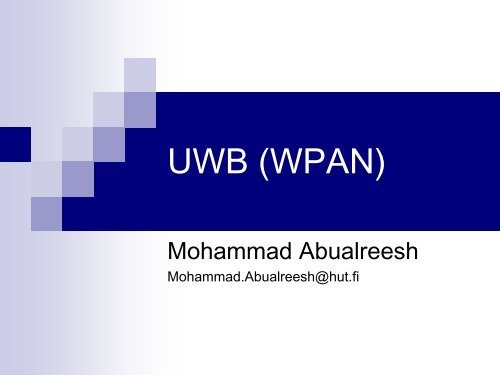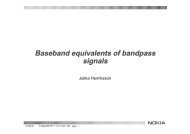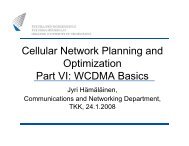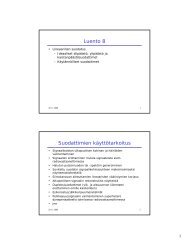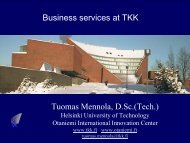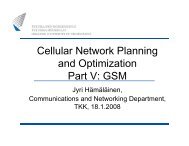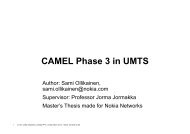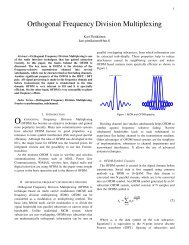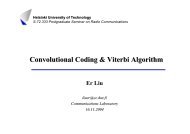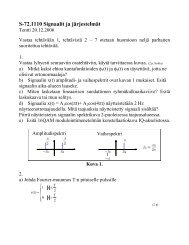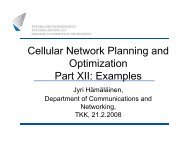UWB (WPAN)
UWB (WPAN)
UWB (WPAN)
Create successful ePaper yourself
Turn your PDF publications into a flip-book with our unique Google optimized e-Paper software.
<strong>UWB</strong> (<strong>WPAN</strong>)<br />
Mohammad Abualreesh<br />
Mohammad.Abualreesh@hut.fi
Outline<br />
• <strong>UWB</strong> basics<br />
• <strong>UWB</strong> for <strong>WPAN</strong>
<strong>UWB</strong> basics
What is <strong>UWB</strong>?<br />
<strong>UWB</strong> is a radio technology that modulates impulse based waveforms<br />
instead of continuous carrier waves<br />
Time-domain behavior<br />
Frequency-domain behavior<br />
Ultrawideband<br />
Communication<br />
Impulse<br />
Modulation<br />
1 0 1<br />
time<br />
3 frequency 10 GHz<br />
(FCC Min=500Mhz)<br />
Narrowband<br />
Communication<br />
Frequency<br />
Modulation<br />
0 1 0 1<br />
2.4 GHz
Channel model
<strong>UWB</strong> Transceiver System Diagram [12].
<strong>UWB</strong> Spectrum<br />
• FCC ruling permits <strong>UWB</strong> spectrum overlay<br />
Emitted<br />
Signal<br />
Power<br />
GPS<br />
PCS<br />
Bluetooth,<br />
802.11b<br />
Cordless Phones<br />
Microwave Ovens<br />
802.11a<br />
-41 dBm/Mhz<br />
<strong>UWB</strong><br />
Spectrum<br />
“Part 15 Limit”<br />
1.6 1.9 2.4<br />
3.1<br />
5<br />
Frequency (Ghz)<br />
10.6<br />
• FCC ruling issued 2/14/2002 after ~4 years of study & public<br />
debate<br />
• FCC believes current ruling is conservative
Theoretical Data Rates over Range<br />
<strong>UWB</strong> shows significant throughput potential at at short range
Performance Analysis with encoding rules
So why is <strong>UWB</strong> so Interesting?<br />
• 7.5 Ghz of “free spectrum” in the U.S.<br />
FCC recently legalized <strong>UWB</strong> for commercial use<br />
Spectrum allocation overlays existing users, but its allowed<br />
power level is very low to minimize interference<br />
• Very high data rates possible<br />
500 Mbps can be achieved at distances of 10 feet under current<br />
regulations<br />
• “Moore’s Law Radio”<br />
Data rate scales with the shorter pulse widths made possible<br />
with ever faster CMOS circuits<br />
• Simple CMOS transmitters at very low power<br />
Suitable for battery-operated devices<br />
Low power is CMOS friendly
Ultra Wideband Characteristics<br />
• Extremely low transmission energy ( less than 1mW)<br />
• Very high bandwidth within short range (200Mbps within 10m)<br />
• Extremely difficult to intercept<br />
– Short pulse excitation generates wideband spectra – low energy<br />
densities<br />
– Low energy density also minimizes interference to other services<br />
• Multipath immunity<br />
• Commonality of signal generation and processing architectures<br />
• Radar<br />
– Inherent high precision – sub-centimeter ranging<br />
– Wideband excitation for detection of complex, low RCS targets
Ultra Wideband Characteristics<br />
• Geolocation/Positioning<br />
– Sub-centimeter resolution using pulse leading edge detection<br />
– passes through building blocks, walls, etc. (LOS not required)<br />
• Low Cost<br />
– Nearly “all-digital” architecture<br />
– ideal for microminiaturization into a chipset<br />
• Frequency diversity with minimal hardware modifications
<strong>UWB</strong> Advantages<br />
• Capacity<br />
possibility of achieving high throughput<br />
• Low power & Low cost<br />
Can directly modulate a baseband pulse<br />
Can be made nearly all digital<br />
High capacity with lower Tx power levels<br />
• Fading robustness<br />
Wideband nature of the signal reduces time varying amplitude<br />
fluctuations (?)<br />
Relatively immune to multipath cancellation effects<br />
• Path delay ~ 1ns > pulse duration<br />
• But don’t we build RAKE just to rebuild the multipath thing ?<br />
• What about ISI ?<br />
• Position location capability<br />
Developed first as radar technology (!)<br />
• Flexibility<br />
Can dynamically trade-off throughput for distance
<strong>UWB</strong> for <strong>WPAN</strong>
<strong>WPAN</strong> requirements<br />
Essential requirements include:<br />
• Wireless - without line-of-sight limitations<br />
• Low power consumption<br />
• Optimized for power management and QoS‘<br />
• Ad-hoc’ networking support<br />
• Multi-device networks<br />
• Cross-network interference tolerance<br />
• Small size and easy integration into variety of devices<br />
• Low cost & complexity
IEEE802.15 project (<strong>WPAN</strong>)
Summary of <strong>WPAN</strong> standards
Example: transfer rate
<strong>UWB</strong> Application : <strong>WPAN</strong><br />
• Desktop and Laptop PCs<br />
High res. printers, scanners,<br />
storage devices, etc<br />
Connectivity to mobile and<br />
CE devices<br />
• Mobile Devices<br />
Multimedia files, MP3, games, video<br />
Personal connectivity<br />
• CE Devices<br />
Cameras, DVD, PVR, HDTV<br />
Personal connectivity<br />
STBs<br />
HDTV<br />
PVRs<br />
CE<br />
Cluster<br />
VCRs<br />
camcorders<br />
MP3<br />
console<br />
games<br />
DVD<br />
cameras<br />
players<br />
audio<br />
camera<br />
systems<br />
phones<br />
speakers<br />
storage<br />
devices<br />
printers<br />
Mobile<br />
Cluster<br />
mobile<br />
phone<br />
tablets<br />
PDAs<br />
handheld PCs<br />
laptops<br />
scanners<br />
PC<br />
Cluster<br />
Scanners<br />
3G<br />
handsets<br />
One One PHY PHY for for Personal Computing, Consumer Electronic<br />
and and Mobile, Wireless Personal Area Area Connectivity
HW<br />
• Define <strong>UWB</strong>, features, and benefits.<br />
• Describe the potential application of <strong>UWB</strong><br />
for <strong>WPAN</strong>
Reference<br />
• Porcino, D., Hirt, W., Ultra-Wideband Radio Technology: Potential and Challenges Ahead,<br />
Communications Magazine, IEEE, Volume: 41 , Issue: 7 , July 2003 Pages:66 - 74.<br />
• Peter Hulbert and Malcolm Streeton, ULTRA WIDE BAND an overview, Roke Manor<br />
Research. Available:<br />
http://www.roke.co.uk/download/articles/<strong>UWB</strong>_An_Overview_LPRA2003.pdf<br />
• Nicolas Demassieux, An Overview of Ultra Wide Band Indoor Channel Measurements and<br />
Modeling, European Communication Research Labs, Motorola Labs, May 15, 2002. Available:<br />
http://www.ctr.kcl.ac.uk/Pages/4GForum/2002/CD/P1/P-6.ppt.<br />
• Ultra Wideband Systems , Roke Manor Research. Available:<br />
http://www.roke.co.uk/uwb/default.asp.<br />
• Young Man Kim, Ultra Wide Band (<strong>UWB</strong>) Technology and Applications, NEST group The Ohio<br />
State University, July 10, 2003. Available: http://www.cse.ohio-<br />
state.edu/siefast/presentations/ultra-wide-band-kimyoung-2003/ultra-wide-band-kimyoung-<br />
2003.ppt#270,17,<strong>UWB</strong> Test/Evaluation Kit.<br />
• Johann Chiang, “A War to End All Wars” Between <strong>UWB</strong> <strong>WPAN</strong> Systems. Available:<br />
http://www.ece.utexas.edu/wncg/ee381v/student_report/Johann.pdf.<br />
• Robert Szewczyk, <strong>UWB</strong>: Technology and implications for sensor networks, NEST group The<br />
Ohio State University, July 27, 2004. Available:<br />
http://www.cs.berkeley.edu/~binetude/NEST/<strong>UWB</strong>.ppt#283,4,<strong>UWB</strong> Signals.
Reference<br />
• Ebrahim Saberinia, Ahmed H. Tewfiq, Multi-user <strong>UWB</strong>-OFDM Communications, Communications, Computers<br />
and signal Processing, 2003. PACRIM. 2003 IEEE Pacific Rim Conference on , Volume: 1 , 28-30 Aug. 2003<br />
Pages:127 - 130 vol.1.<br />
• David G. Leeper, PhD, Singapore Ultrawideband Programme, Consumer Electronics, Intel Communications<br />
Group, May 24, 2004. Available:<br />
http://www.ida.gov.sg/idaweb/doc/download/I2887/<strong>UWB</strong>,_OFDM_and_Cognitive_Radio.pdf.<br />
• Safwat, A.M, Ultra-Wideband (<strong>UWB</strong>) Technology: Enabling high-speed wireless personal area networks, Intel.<br />
Available: http://www.intel.com/technology/ultrawideband/downloads/Ultra-Wideband.pdf.<br />
• Zoubir Irahhauten, Homayoun Nikookar, and Gerard J. M. Janssen, An Overview of Ultra Wide Band Indoor<br />
Channel Measurements and Modeling, Wireless Communications, Microwave and Wireless Components<br />
Letters, IEEE [see also IEEE Microwave and Guided Wave Letters] , Volume: 14 , Issue: 8 , Aug. 2004<br />
Pages:386 – 388.<br />
• <strong>UWB</strong> Development, Institute of Microelectronics (IME), Singapore <strong>UWB</strong> Community. Available:<br />
http://uwb.tech.org.sg/devResIme.html.<br />
• J. Farserotu, <strong>UWB</strong> FOR WSN, CSEM, Neuchatel, 14 October 2003. Available: http://www.mics.org/MV2003-<br />
Present/Ma14/<strong>UWB</strong>-Farserotu.pdf.<br />
• M. A. Rashid, J. Y. Khan and J. Wall, Bluetooth-Based Wireless Personal Area Network for Multimedia<br />
Communication, Electronic Design, Test and Applications, 2002. Proceedings. The First IEEE International<br />
Workshop on , 29-31 Jan. 2002 Pages:47 – 51.<br />
• Robert F. Heile,<strong>WPAN</strong> Application Space, IEEE 802.15. Available: http://csi.usc.edu/INTEL-<br />
USC/presentations/Heile.pdf
Thank you!<br />
• Q&A’s


